Ford finds new Focus on global unison
By John Gilbert
For over a decade, U.S. consumers have been able to buy Ford’s Focus as its entry-level compact car that was inexpensive, pretty good, and not bad for styling and features. But it was a product of this country’s disinterest in small cars, which allowed manufacturers to eagerly make bigger-is-better vehicles for outrageous prices that led to ludicrous profits flowing into Detroit–all the way to, or near, bankruptcy.
All that while, the more knowledgeable consumers heard about the “European Focus.” Similar in size, but nothing else, the European Focus had a platform made by Ford affiliate Volvo for its smallest sedans, and it had an engine made by Ford affiliate Mazda, which meant it was potent, fuel-efficient, quick and fun to drive, while the suspension was the product of European Ford experts. U.S. buyers couldn’t figure out why we couldn’t get the European Focus, but an underlying reason was that the European demand for small cars is so intense that there actually is a varying level of small cars, and the Focus was expensive enough to make and sell that it qualified as an upper-level compact. If it was brought into the U.S., it would cost too much to be feasible in a country that has been less than demanding about its small cars.
Times, like gasoline prices, change. And the last time gas prices rose, it sounded the finishing bell for bigger-is-better vehicles, and there was an irreversible move toward downsizing, but also providing well-equipped smaller cars. Ford has been at the leading edge of the movement, striving for smaller engines that will perform better than previous bigger and less fuel-efficient engines, and bringing back the subcompact Fiesta, which is large enough for a young family–or anyone else who might think a quick and agile small car that can deliver an honest, real-world 40 miles per gallon is a good thing.
Coincidentally, Ford timed its global move well. It is time for a new Focus, and it is time to replace the long-toothed U.S. Focus. Just coming out now, as a 2012 model, there will be one global Focus, and it will be sold worldwide. There are a couple of cop-outs there, because the U.S. market is so fickle. As it did with the Fiesta, making a sleek sedan alongside the hatchback because U.S. buyers haven’t shared the zeal of Europeans for hatchbacks, Ford is offering the Focus as both a hatchback and sedan. There also are certain things for the U.S. only, and a few other things for Europe and other global locations that won’t be on the U.S.-issue Focuses. Read more
Chrysler aims high, 300 hits target
By John Gilbert
There were three distinct reasons why I was ready to be impressed by the 2011 Chrysler 300.
First, when the 300 was resurrected for a reintroduction five years ago, the look was abrupt and bold, and bricklike. I’m all for abrupt and bold styling, but I am definitely not a fan of designing vehicles to resemble a brick. The Chrysler 300 turned out to be North American Car of the Year, proving that Chrysler was wise in its polarizing design, because love/hate polarity works if enough of the “love” side buys your car. Now that the Chrysler 300 is not only due for replacement, but is representing a microcosm of Chrysler corporation itself in its battle for survival, I was hoping the new 300 would improve on the outgoing brick…I mean, car.
Secondly, a number of cynics in the media seem to be ready to let Chrysler fail, after General Motors and Chrysler both required government aid to get to bankruptcy procedures that avoided going out of business. While most seem to be pulling for GM, it seems that the cynics among auto journalists have no sense of pulling for the underdog as Chrysler battles to reach sea-level.
The third reason is more self-gratifying, perhaps, but the 300’s introduction was being held in San Diego, where folks were grumbling about the January temperature dipping to something like 67 degrees. That was during a January week when the temperature in Minnesota was somewhere between 15-25 degrees below zero. I feel fully invigorated when it gets extremely cold, but this has been a winter where I’ve learned that there can be limits to necessary invigoration, and then it’s nice to get away to somewhere like…San Diego. So it would be a nicer trip if the Chrysler 300 was good, too.
The new 300 will be a worthy flagship for the rising prospects of Chrysler. It is just now making its way to dealerships, and once it shows up, consumers can climb in and around it in a setting more realistic than the Detroit or Chicago auto shows, and find out that the new car is a significant step forward — for the car, and the corporation.
Fiat is taking over Chrysler, and the merger of those corporate minds is perfectly timed. The Italian flair for design and style is notable, but Fiat officials also seem genuinely impressed with Chrysler’s history and potential in the marketplace. Chrysler designers and engineers, meanwhile, have been focused on impressing their new owners. When we met a carefully aligned group of 300s parked on a pier in San Diego’s harbor, Olivier Francois, the new president and CEO of Chrysler Brand’s segment, was about to address the assembled media members when the microphone wouldn’t work.
“We’ve put our money in the car,” Francois said, “so there is no money for microphones.”
A lively wit is a key ingredient for a successful automobile executive these days, and Francois was sharp. “We wanted to prove to the world that you don’t have to cross the ocean to get a great car from Chrysler,” Olivier said. “We think the 300 will reignite the full-size sedan segment. It’s not easy to follow the most-decorated sedan ever, but we’ve bench-marked the best sedans in the world for quality, materials, fit and finish, and performance, and we think the new 300 is not only beautiful, but it will perform.”
By setting up vehicles as the best in various categories as bench-marks, Chrysler learned its own limits and capabilities. A car that is best in some areas might be lacking in others, and while Chrysler isn’t claiming to have beaten all of them, by making the new 300 competitive with all of them in all categories makes the new 300 better than most in combining the assets into one vehicle. Read more
Hyundai elevates Elantra to head of compact class
By John Gilbert
The 2010 Hyundai Elantra is a nice, competitive sedan, worthy of consideration against the Toyota Corolla, Nissan Sentra, or even the Honda Civic or Mazda3 among stalwarts of the compact class because of its inexpensive price sticker and impressive warranty. However, as seems to be the case in recent Hyundai philosophy, why stay with competitive when superlatives can be attained? For 2011, the totally renovated Elantra is, in a word, superlative.
The transformation is similar to what Hyundai achieved with the midsize Sonata a year ago. The previous Sonata was a good midsize car, competitive if unexciting and uninspiring — but Hyundai brought all its current technology together and created its own pedestal in the auto industry with the 2011 Sonata, which combines style, substance, price, technology, and performance all into one outstanding vehicle.
Move down a step, from midsize to compact, and the new Elantra for 2012 greatly resembles a downsized Sonata, with dramatic and curvaceous styling, surprising interior room, 40-miles-per-gallon efficiency from its strong new engine/transmission combination, and all at a price that could make it the new standard of a suddenly revitalized segment. With the Ford Focus, Chevrolet Cruze and Honda Civic rising up to meet the demands of consumers who want fuel-efficiency in the face of over-$3 gas prices, jumping into the thick of that battle is no small task. But the Elantra clears that hurdle with graceful ease.
The Cruze and the Focus, as well as the smaller Ford Fiesta, all have come out with impressive entries for 2011, and all have a specialty model, slimmed down and streamlined, and aiming to reach 40 miles per gallon. Hyundai president John Krafchik scoffs at that, saying why don’t rivals build their base or mainstream models to achieve the highest fuel economy? Why should customers have to pay more for better fuel-efficiency? With that, Hyundai rolls out the Elantra, which will be built alongside the Sonata in Hyundai’s plant at Montgomery, Ala., with the projection that all Elantra models will top 40 mpg. Read more
Smaller cars pace Detroit Auto Show reality check
By John Gilbert
DETROIT, MICH. — For the last couple of years, a grey cloud of doubt and pessimism provided the undercurrent at the North American Auto Show. But when the 2011 show kicked off with two media preview days on January 10-11, all was positive and uplifting by comparison. That hardly means the traditional domestic Big Three of Ford, General Motors and Chrysler are on secure footing, but it does mean they seem to be on the right track for returning to respectability and, more important, profitability.
So eager are members of the automotive media to help out with the respect for the “home” teams, 49 North American media types kicked off the “Go Detroit” theme by naming the Chevrolet Volt the 2011 North American Car of the Year, and the Ford Explorer the Truck of the Year. The decided leaning toward domestic nameplates among the journalist jury of independent voters showed the plug-in electric Volt collected 233 points, to 163 for the runner-up Hyundai Sonata, and 94 for the pure-electric plug-in Nissan Leaf. Explorer’s margin among truck finalists was larger, with 253 points to 138 for the runner-up Jeep Grand Cherokee, and 99 for the Dodge Durango in a battle among three domestics.
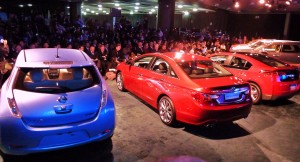
Electric Nissan Leaf, left, Hyundai Sonata, winning Chevrolet Volt awaited Car of the Year decision.
The awards all have significant merit, although they also show that the manufacturers might have come farther from the “good old days” than the media, in getting past two major hurdles — expensive vehicles, and large SUVs. In the industry, consumer demands have caused every manufacturer to strive to build more fuel-efficient vehicles costing under $25,000, and the same manufacturers have accepted the public avoidance of large, truck-based SUVs and are building compact crossover SUVs so fast they are one of the largest segments in automotives. The media voters, however, chose the Volt’s electric-with-gas-engine-backup technology, even though it costs over $40,000 and is not yet available throughout the country, over the Sonata, which has a South Korean name but is designed and built entirely in the U.S., costing about half the Volt’s price tag.
The same held in trucks, where the Explorer has been redesigned as a unibody SUV, expanded to three-row length, and it beat out Ford’s own revised and maybe more-popular Edge crossover to gain finalist stature from the jury, along with the reincarnated unibody Durango, meaning two of the three finalists were elongated three-row vehicles, while consumers have emphatically made compact two-row-seating crossovers — including the runner-up Grand Cherokee — the top-sellers in the segment. Read more
Fiat helps Dodge, Chrysler get new life for 2011
By John Gilbert
What seems like identity-crisis time for Chrysler and Dodge may be the dawn of a promising upside. Getting through the transition of being purchased by Italy’s Fiat conglomerate, Dodge and Chrysler could see immediate benefits, based on the introduction of their revised fleet of vehicles for 2011.
The words style and refinement haven’t often been used favorably to describe Chrysler or Dodge vehicles recently, and, except for minivans, it’s been years since anyone pointed to anything from the corporation as a standard of interior finish and style. But everything in the Chrysler line, and almost everything behind a Dodge nameplate is revised and improved for 2011. Some of the products, such as the Dodge Grand Caravan or the Chrysler Town & Country, don’t look all that different, but whether the sheet metal is changed or not, the engines, drivetrains, structure, and suspension have been changed and vastly improved in every model.
When you consider it, the union of Fiat with ChryslerDodge/Jeep is a natural. Fiat wanted to return to the U.S. market, but lacked a nationwide network. Chrysler needed a truly competitive small car, and Fiat has the 500, a tiny but strong global commuter car. Chrysler, LLC, needed financial backing, and Fiat has money. But nobody anticipated the instant changeover that appears to have taken place. Read more


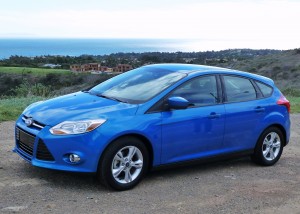
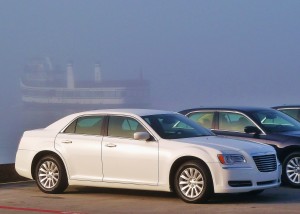
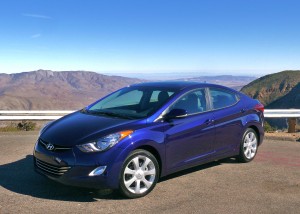
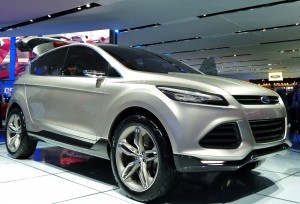
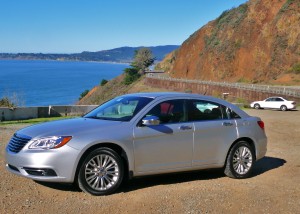
 John Gilbert is a lifetime Minnesotan and career journalist, specializing in cars and sports during and since spending 30 years at the Minneapolis Tribune, now the Star Tribune. More recently, he has continued translating the high-tech world of autos and sharing his passionate insights as a freelance writer/photographer/broadcaster. A member of the prestigious North American Car and Truck of the Year jury since 1993. John can be heard Monday-Friday from 9-11am on 610 KDAL(www.kdal610.com) on the "John Gilbert Show," and writes a column in the Duluth Reader.
John Gilbert is a lifetime Minnesotan and career journalist, specializing in cars and sports during and since spending 30 years at the Minneapolis Tribune, now the Star Tribune. More recently, he has continued translating the high-tech world of autos and sharing his passionate insights as a freelance writer/photographer/broadcaster. A member of the prestigious North American Car and Truck of the Year jury since 1993. John can be heard Monday-Friday from 9-11am on 610 KDAL(www.kdal610.com) on the "John Gilbert Show," and writes a column in the Duluth Reader.